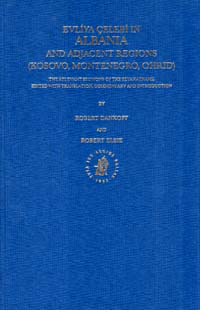|
Robert Dankoff and Robert
Elsie
Evliya Çelebi in Albania and adjacent regions
(Kosovo, Montenegro, Ohrid)
The relevant sections of the Seyahatname
Edited with translation, commentary and introduction
by Robert Dankoff and Robert Elsie
Evliya Çelebi's Book of Travels. Land and people of
the Ottoman Empire in the seventeenth century
A corpus of partial editions, edited by Klaus Kreiser
Volume 5
ISBN 90-04-11624-9
Brill, Leiden,
New York, Cologne 2000
307pp.

 INTRODUCTION INTRODUCTION
The Turkish traveller Evliya Çelebi
toured Kosovo in December of 1660, northern Albania and Montenegro
in February of 1662, and southern Albania in November of 1670.
In the present volume, we have extracted his descriptions of
these regions from the very extensive accounts of his peregrinations
in the Balkans, covering much of Books V through VIII of his
Seyahatname or Book of Travels.
The occasion of the first of these journeys
was the transfer of Evliya's patron, Melek Ahmed Pasha, from
the governorship of Bosnia (residence: Banja Luka) to that of
Rumeli (residence: Sofia). In the Pasha's train, Evliya passed
through Kosovo stopping at Mitrovica, Vushtrria (Vuçitërna),
Kosovo Polje, Prishtina and Kaçanik. His account of this
journey, between Novi Pazar and Skopje, is contained in the autograph
ms. of Book V, fols. 167a-169a. This comprises Part I of the
present volume. This section is edited here for the first time.
Translations into Serbo-Croatian, based on the inadequate printed
text (Istanbul, vol. 5, 1897, pp. 547-553), are found in Cohadzic
1905 (pp. 25-27) and in Sabanovic 1954 (repr. 1979, pp. 268-280,
and 1996). There are also Albanian translations in Vuçitërni
1930 and in Kaleshi 1955 (pp. 424-432).
A little over one year later, Melek Pasha
had just returned to Belgrade from active engagement with the
Ottoman troops in Transylvania when he was summoned to the capital.
Short of funds, he sent Evliya to Albania to collect some debts.
Evliya stopped in Tirana, Lezha (Alessio), Shkodër (Scutari),
Podgorica and Ulcinj, and then proceeded to Sofia where he was
reunited with Melek Pasha before returning to Istanbul. His account
of this journey, between Mileshevo and Skopje, is contained in
the autograph ms. of Book VI, fols. 33a-36b. This comprises Part
II of the present volume. This section, which until now has only
been available in an inadequate printed text (Istanbul, vol.
6, 1900, pp. 106-117), is also edited here for the first time.
The early Albanian translation in Vuçitërni 1930
was based on the printed Turkish text (111.23), and also excludes
for instance the sample of the Albanian language.
Evliya participated in the Candia campaign
and the final Ottoman conquest of Crete in 1669. The following
year, after the capture of Mania in the Peleponnese, the Ottoman
commander Ali Pasha sent Evliya on a mission to Albania requesting
troops and workmen to help rebuild the fortress of Zarnata, and
thus to safeguard Mania against reconquest by the Venetians.
Evliya passed through Delvina, Gjirokastër, Tepelena, Përmet,
Berat, Vlora, Durrës, Kavaja, Elbasan, Ohrid and Pogradec
before continuing on through Macedonia and Bulgaria to the Ottoman
court in Edirne. His account of this journey from Corfu to Macedonia,
is contained in the autograph ms. of Book VIII, fols. 352a-372b.
This comprises Part III of the present volume. This section has
been available in a fairly good edition (Istanbul, vol. 8, 1928,
pp. 668-746), and is here re-edited on the basis of the autograph
ms. There is a rudimentary Albanian translation of this section
in Vuçitërni 1930 and a detailed analysis of this
journey in Babinger 1930.
The Seyahatname contains a wealth
of material on cultural history, folklore and geography from
the countries Evliya Çelebi visited. For seventeenth-century
Albania, and in particular for the interior of the country, it
constitutes a mine of information and is a work of inestimable
value. Other sources of Albanian history for this period are
rare. The little which has survived from the nebulous annals
of early Albanian history has been compiled in Zamputi 1989,
1990. Among such documents are legal and merchant correspondence
with Venice and Ragusa (Dubrovnik), ecclesiastical reports to
the Propaganda Fide in Rome, and Turkish registers. All these
works pale in significance, however, when compared to the relevant
sections of the Seyahatname of Evliya Çelebi edited
here.
Evliya's work offers us detailed itineraries
through a virtual terra incognita, including, among many
other things, surprisingly accurate descriptions of market towns,
fortresses, mosques, pilgrimage sites and pleasure-grounds. His
writings are of particular interest for our knowledge of the
presence and early spread of Islam and the dervish sects in Albania,
evincing as he does here all the elements of a refined Islamic
culture, of which tragically few traces have survived the course
of history.
Robert Dankoff and Robert Elsie
1999

CONTENTS
- Map
- Introduction
- Text and Translation
Part 1: Kosovo, 1660
Part 2: Northern Albania and Montenegro, 1662
Part 3: Southern Albania, 1670
- Bibliography
- Glossary
- Index
- Facsimile of the Manuscript
- Plates

|
 INTRODUCTION
INTRODUCTION